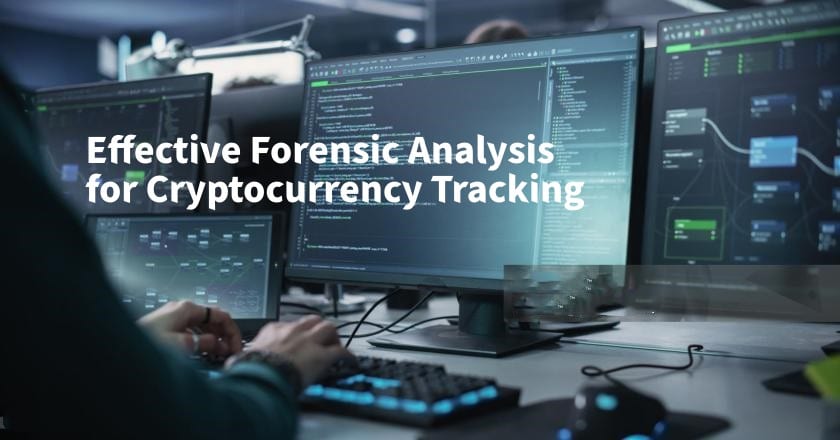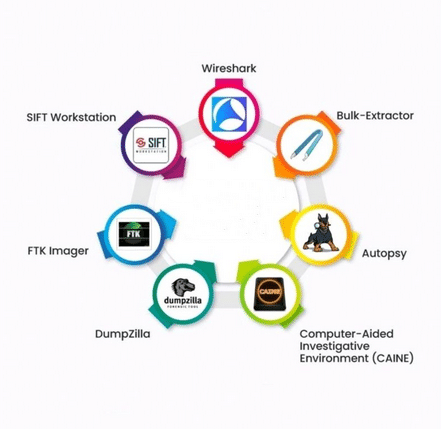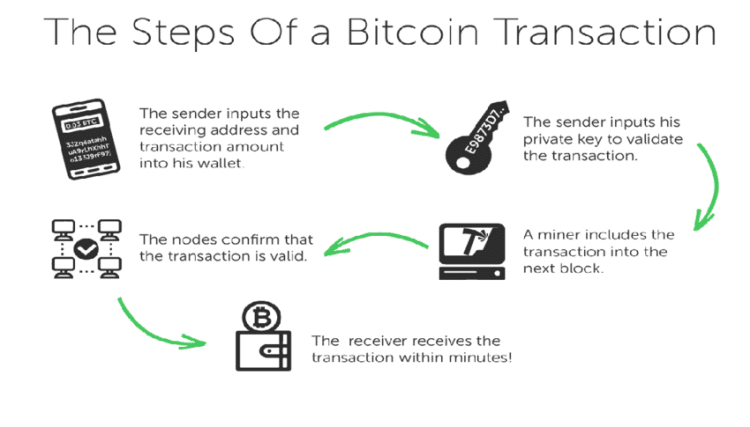Digital forensic analysis is an important method that uses scientific methods to get back information from digital devices that has been lost or stolen, usually in the context of theft. This field is very important for keeping track of bitcoin trades, where digital trails are studied to find activities that might be illegal.It’s very important to keep track of bitcoin trades. As digital currencies become more a part of our financial systems, being able to track these activities is important for keeping things safe, following the rules, and stopping scams.The point of this article is to look at how forensic analysis can help us understand and keep an eye on the flow of coins. By looking at certain digital forensic tools and methods, readers will understand how this process helps keep digital trades honest and safe.
Effective Forensic Analysis for Cryptocurrency Tracking

-
Content
- What Is Cryptocurrency Transactions?
- Tools and Techniques in Forensic Analysis
- Steps Involved in Tracking Cryptocurrency Transactions
- Case Studies and Examples
- Challenges and Advancements
- Conclusion
-
Content
- What Is Cryptocurrency Transactions?
- Tools and Techniques in Forensic Analysis
- Steps Involved in Tracking Cryptocurrency Transactions
- Case Studies and Examples
- Challenges and Advancements
- Conclusion
What Is Cryptocurrency Transactions?
1. Decoding Cryptocurrency Transactions
The way cryptocurrency transfers work is very different from how standard banking systems work. Using blockchain technology, these events are written down on a public ledger that anyone can see. In general, this is how it works:
- Initiation: When one person chooses to send cryptocurrency to another, this is called an exchange. Digital wallets are used for this. These wallets store the cryptographic keys needed to send and receive coins.
- Verification: Nodes, which are computers that are part of the network, are what make cryptocurrency networks work. They check transfers. These nodes make sure the exchange is legal and check to see if the sender has enough money.
- Recording: After being checked, the transaction is added to a new data block with other transactions. The ledger is then brought up to date by adding this block to the current blockchain.
Even though cryptocurrency activities are kept on a public log, they are very private. Wallets can only be identified by their fake addresses, which hides the real names of the people who own them. But while you can remain anonymous, you can also be seen. Most people don’t know who the addresses belong to, but everyone can see the transactions, which makes it possible to track them down to the transaction level.
2. Anonymity vs. Transparency in Cryptocurrency Transactions
This dual nature makes a one-of-a-kind environment where users who care about privacy can feel safe without giving up the structural openness that stops fraud and abuse.
Tools and Techniques in Forensic Analysis
1. Leveraging Forensic Tools for Cryptocurrency Tracking
In the field of digital forensic analysis, special tools have been made to help keep track of bitcoin activities very carefully. These tools have the features you need to break down and analyse the digital traces left behind by coin trades and swaps.
- Encase: In the investigative community, Encase is well-known for its wide range of features for getting data from different digital devices and analysing it. It is a key part of putting together broken bitcoin data, which lets experts find the sources of transactions.Contact to get a Free Trial now!
- Wireshark: This network protocol tester is very important for keeping an eye on and recording live network data. Wireshark can be used to monitor and log the data bits that are part of a cryptocurrency exchange. This gives a detailed picture of how the transaction works.Click to get a Forensic Download here!
- DRS: Since the DataRecovery System (DRS) by SalvationDATA is an expert in rescuing and analysing data, it can be used to get back coin transaction records that have been lost or damaged. It has strong features that make sure even the most private data can be retrieved and looked over.
- FTK: One more powerful tool used for digital investigations is the Forensic Toolkit (FTK). It is very good at organizing and looking through huge amounts of data, like blockchain databases, to find coin transaction information fast.
2. Exploring Data Mining and Pattern Recognition Techniques
In addition to these tools, different data mining and pattern recognition methods are used to make the research process even better:
- Disk Imaging: With this method, a copy of the storage media is made bit by bit. For cryptocurrency, this means making a perfect copy of the storage in a wallet and keeping all of its transaction logs and records.
- Data Carving: Data hacking looks through random data on disc pictures to find traces of cryptocurrency transactions. It can be used to get data that has been hidden or removed.
- Memory Analysis: This method looks at the variable memory (RAM) of devices to get details about processes that are going and how the system interacts during cryptocurrency trades. This gives us information about how crypto wallets work.
- Reverse Steganography: Some times, private information about transactions is hidden by steganography, which means hiding data in other files or pictures. Untangling this material, which reveals secret transaction data, is what reverse steganography is all about.
Strong forensic tools and advanced data analysis techniques work together to make sure that digital activities are thoroughly checked. This shows how useful digital forensic analysis is in today’s financial security environments. This all-around method not only helps with tracking, but it also helps with following the law and investigative probes.
Steps Involved in Tracking Cryptocurrency Transactions
To get accurate results, tracking cryptocurrency trades needs to be done in a planned way using a number of detective methods. Here is a list of the most important steps:
1. Collection of Data from Blockchain
Getting data straight from the blockchain is the first step in forensic analysis. This shared log keeps track of all cryptocurrency activities, making it a main source of information. Experts in forensics use special equipment to get this data, making sure they have a full set of records that includes all transaction timestamps, amounts, and wallet addresses involved.
2. Analysis of Transaction Patterns
After getting all the information, the next step is to look at how the deals fit together. This means looking at how often, how much, and when transfers happen to find any trends or oddities that might point to illegal behaviour. This process is automated with tools like network analysis and pattern recognition algorithms, which makes it easy to work with big datasets.
3. Identifying Wallet Addresses and Tracing Transactions
Once the trends are known, experts work on finding the exact wallet addresses that were used in the transactions. This step is very important for setting up the flow of money and connecting different activities to the same wallet. Analysts can make a picture of transactions and find possible leads for further study by knowing how different addresses interact with each other.
4. Linking Transactions to Individuals or Entities
Putting real-world names on faceless blockchain transactions may be the hardest part of the last step. To do this, you need to use data and clues from other places, like exchanges, online wallets, and other digital trails, to connect a blockchain address to a person or business. In order to get the data rights and help needed for this step, people often have to work together with law officials and banking institutions.
Case Studies and Examples
Forensic research has been very helpful in figuring out what happened with illegal activities in the complicated world of digital currencies. Here are two well-known cases of tracking cryptocurrencies that worked:
1. The Silk Road Seizure
The Silk Road, an online black market where illegal drugs were mostly sold, is likely the most well-known case involving cryptocurrency. Analysts of digital evidence were very important in finding Bitcoin activities that were very important to the market. By carefully looking at trends of transactions and the flow of money, agents were able to find and arrest Ross Ulbricht, the founder, in 2013. This case showed how digital forensic analysiscan be used to see through the secrecy that comes with cryptocurrency.
2. The Mt. Gox Hack
Someone stole about 850,000 Bitcoins from Mt. Gox in 2014, when it was one of the biggest Bitcoin platforms. The company then filed for bankruptcy. Forensic experts utilized advanced forensics data analysis techniques to trace the stolen Bitcoins. Their study showed complicated webs of transfers that led to different wallets, some of which were linked to well-known people or groups.This tracking not only highlighted the potential for recovering stolen assets but also emphasized the importance of forensic phone analysis and forensic video analysis in corroborating digital data with real-world events.
Challenges and Advancements
The field of cryptocurrency forensic analysis faces a dynamic landscape of challenges and advancements. Here’s how experts are addressing these complexities and leveraging new technologies to refine their methods:
1. Technical Challenges in Cryptocurrency Tracking
The fact that cryptocurrencies are decentralised and blockchain technology protects privacy are big problems. The information about transactions is spread out over a global network. Since there is no central authority, it is hard to keep track of illegal activities without using complex tools that can look at data from multiple blockchains. Using both services and privacy coins at the same time makes it harder to track transfers back to where they came from, which means that surveillance methods need to be updated all the time.
2. Legal and Regulatory Issues
Cryptocurrency is regulated in a grey area, and different places have different rules. This difference makes things hard for forensic analysts who have to keep up with changing legal requirements. Following data privacy laws and getting the right permissions to access private data are big problems that need to be handled carefully to keep from getting in trouble with the law.
3. Emerging Technologies in Digital Forensic Analysis
The area of digital forensics is changing a lot because of progress in machine learning and artificial intelligence. These technologies make pattern recognition faster, make complicated data analysis easier to automate, and make it easier to track down illegal activities. AI is being used more and more by blockchain analytics companies to make prediction models that help find shady actions faster and more correctly.
4. Ongoing Developments and Their Impact
Forensic methods are always getting better because blockchain technology is always changing. As cryptographic security measures get better and more complicated blockchain systems are made, investigative tools need to be constantly researched and changed. As blockchain technology gets better, the methods and tools used to look at and understand its data must also get better.
Conclusion
To sum up, forensic analysis is a very important part of making sure that bitcoin transfers are safe and clear. As we’ve seen, getting from collecting blockchain data to connecting digital activities to real-life names is hard on both a technical and a legal level. Despite this, improvements in digital investigative tools and methods keep making it easier for agents to track and study digital currencies. As technology keeps getting better and forensic analysts learn more about how blockchain works, they are better prepared than ever to deal with the complicated world of cryptocurrency. Going forward, it is very important for these professionals to keep coming up with new ideas and adapting to make sure that digital banking stays safe and responsible. This change in investigative analysis is not only good, it’s necessary for the future of financial safety.





